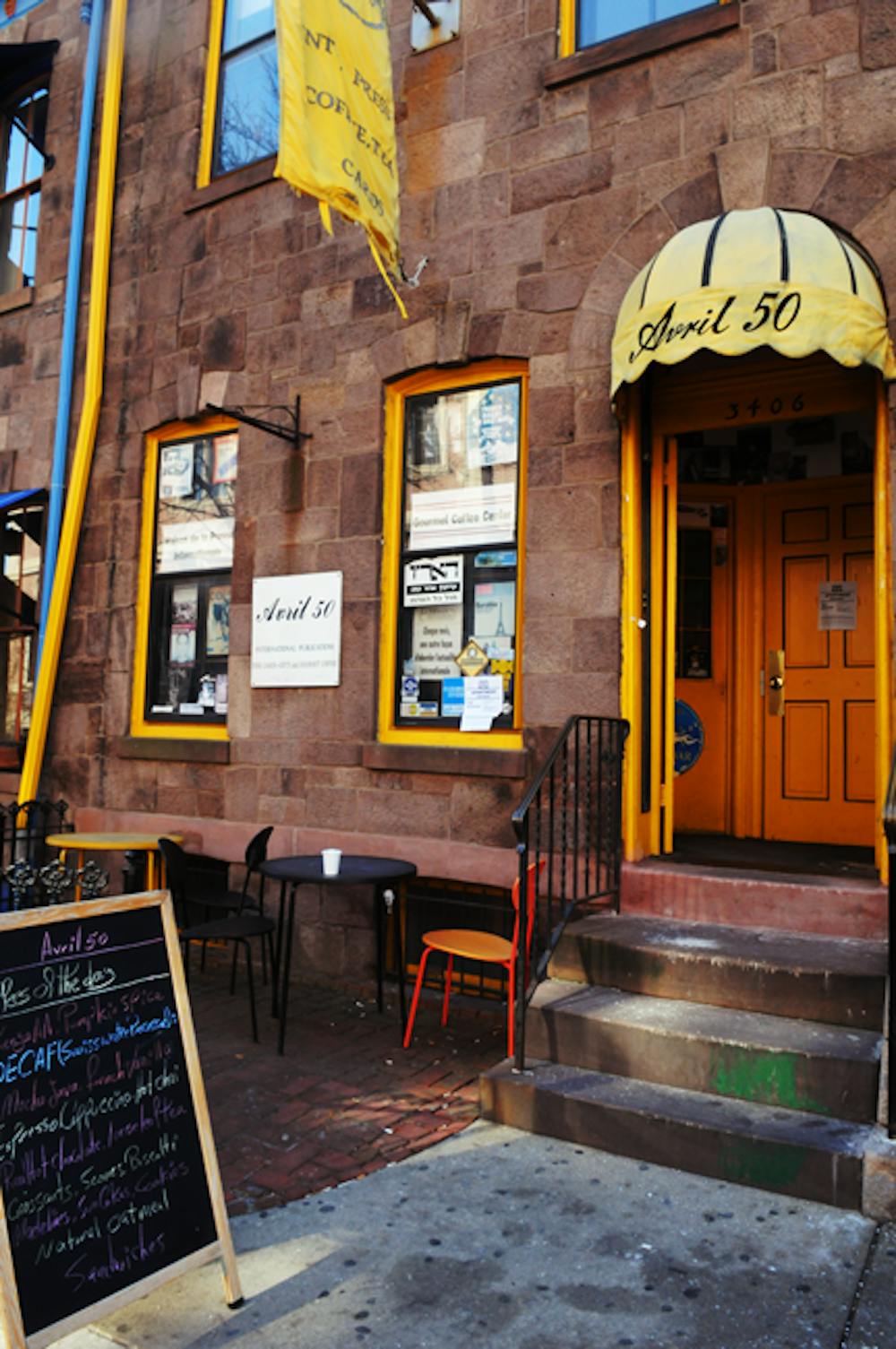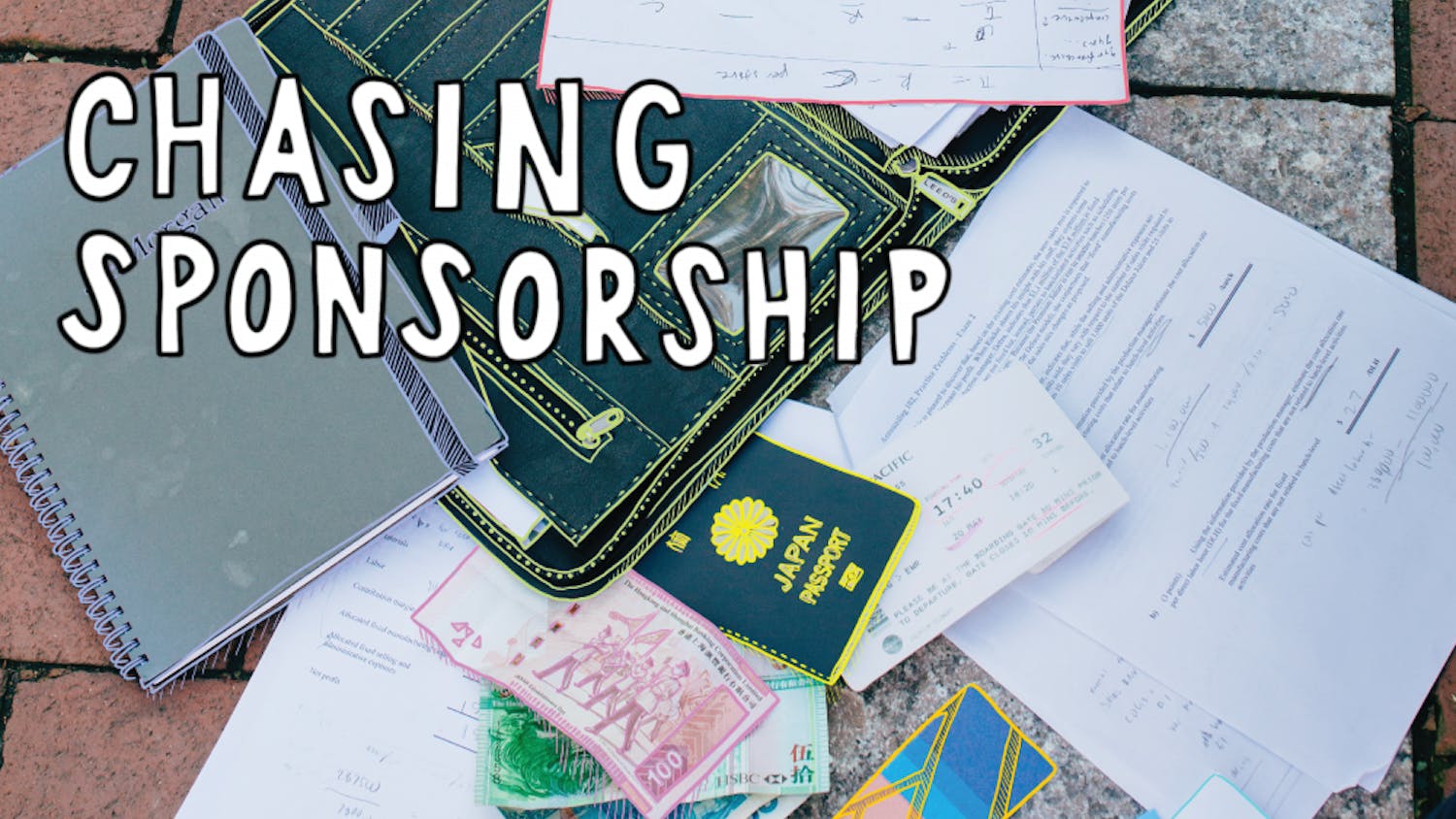Once upon a time on Sansom Street, White Dog Café sold only coffee. Le Bus bakery, now located in Center City (and in plastic sandwich boxes at Williams Café), was an actual bus. New Deck Tavern moved in next to the bakery’s old haunt. John Shahidi, the owner of Avril 50, has seen it all.
“I am the grandfather of this block,” John declares from behind the register. He tells me he misses La Terrasse. “It had the character,” John remembers of the institution that dated back to 1966 before it closed last year. He used to study at the bar.
John speaks Turkish and Farsi. He sleeps four hours a night. He is 62 and always wears a tie. At 5 feet 8 inches, with dark black hair and thick eyebrows that raise easily, he pauses before he responds.
“Are you Avril?” I ask the first time I visit him. Vested, buttoned and turning to face me, John peers up suspiciously through thick rims and pauses. The rich smell of cocoa beans and espresso mixes with the scent of paper. For the past 29 years he has stood behind this counter, sourced these scents, curated this coffee. Most importantly, he has defied the passing of time.
“Yes,” he lies.
I browse. It takes 24 paces to pass through black and white greeting cards, boxed cigars, piled up papers, quirky magazines and journals, tinseled chocolates and eight pots of steaming coffee. A slice of Europe, squeezed and stacked. As I turn to leave, he stops me. “By the way,” he says, grinning. “My name is not Avril. It’s John.”
John consumes 10–12 cups of coffee daily, as well as three to four shots of espresso, “for a boost.” I have never encountered a calm so caffeinated. He likes opera and David Byrne and dislikes change. For almost three decades he has stocked the same snuffs, cigarettes, magazines, journals and reviews.
I worry aloud about the societal shift from print to digital, the ability of the internet to box out smaller presses, prints, periodicals. The torrent over the tactile. The bitwave over the binding. “What do you think?” I ask John. “Well, it hurts.” But it hasn’t stopped him.
In the small comment book that sits above a rotating display of Zippo lighters, someone has written, “This place should be protected by UNESCO.” But it isn’t. It’s protected by patrons.
A customer enters. “You’re almost American, now. You’ve been here, what, 27 years?” he asks. In the 1970s, John and his wife, Shiva Vakili, moved from Iran to the States, beginning Penn graduate degrees in international relations in 1980. When the Iranian revolution broke, the two became unable to return and haven’t in 35 years. “It’s not the same country I left,” John says. “Philadelphia is my home.”
Many who have not yet become so settled here find their place in Avril 50. For doctorate of law student Matteo Erede, the espresso is a taste of Milan. He is stopping in for his third shot of the day. “I’ve asked John if he’ll adopt me,” Matteo says. John practically has. Matteo is in a Penn Law program that allows him to live in Italy, but when he visits Philly approximately twice a year, he always heads straight for Avril 50. “You live on espresso?” I ask.
“On espresso and John’s company.” He mentions he’ll be back for a fourth on his way out the door. (Tomorrow, he’ll bring his friend Giacomo, visiting from Rome, to start the day with a double.)
“Europe in Philly,” the comment book reads. Michel Cluizel chocolates and Gavottes from Paris neighbor Dolfin chocolates from Belgium and Francois Pralus cocoa from Trinidad. Rolls of hand–painted acid–free wrapping paper from Italy unfurl crisply by the register. There is no fiction here, unless you read French or Spanish. Likewise, few of the chocolates bear English labels. “Lait aux noisettes carméliesées et salées” reads a Café Tasse bar from Brussels.
Dark chocolate connoisseurs clamor for the 99% noir bars. But chocolate is an overstatement. The bars are 99% cocoa, which translates to a very full–flavored bitterness. “Don’t chew it so fast,” John tells me. Protocol is to let the chocolate sit on the roof of your mouth for a moment before swallowing. I choke it down and wish I had the sophistication to comment on anything but the astringency. I have the sense to wonder at least how John has managed to sustain the store on niche candies, esoteric design magazines, 50–cent squares of chocolat noir.
But truth be told, most customers don’t come for the gold–foiled chocolates, the textured magazines, the flavored shisha or the vintage Playboys. They come for the coffee. And most ardently for the Avril 50 blend. “That’s the consumer favorite, that one,” says Yasha Shahidi, John’s son, who is currently studying law at Rutgers. He and his father both drink it black. “The elixir of kings,” one customer calls it.
A fresh pot of Avril 50 will inevitably greet your entry to the store. The rest of the selection is a revolving door of the 63 kinds of coffee beans stacked along the street–side wall. Beans from Tanzania, Kenya and Zimbabwe flank those of Guatemala, Indonesia, Colombia and India. But none from Jamaica, John qualifies. “Too expensive.” He laughs.
John took two years to create his signature mix. Like the store, it is named for his birth month and year: April 1950 (a seasoned visitor will recognize ‘Avril’ as the word for April in both Farsi and French). When I ask why John decided to design his own blend, I find myself penning the response before I hear it: “Why not?” Turning down the corners of his mouth with a shrug, John has met many a query with this response.
Jim Corner, architect of New York's High Line, began visiting Avril 50 for a daily cup when he was a graduate student at Penn in the mid–80s. He returned daily while working as a professor at the School of Design and still loves to stop in today, he said via email. He praised John for building a “deeply enriching social place—a small, cozy setting where all the world’s problems get dissected and quite possibly momentarily resolved.” So our print–hostile environment is not only a threat to Avril 50, but the conversation cultivated by its existence as a physical space, its social function as an international crossroads.
As you work your way around the store, thick art, design, fashion and architecture magazines spill out of floppy stacks and into the walkway. Vogue India flanks Vogue Australia and Vogue Japan, Elle Italy naturally next to Elle Spain. “May You Live in Interesting Times” reads the subhead to the Fall/Winter edition of GARAGE, above a floral cartoon of a redhead wielding a machine gun and an emoticon.
All this squeezed into a room that rivals my own in square footage.
Avril 50 hosts over 2,500 publications. Meat Paper offers “your journal of meat culture.” BLOW is a “collaborative, libertarian experience” around fashion, nudity and art. Baseline, a hub for international typographics. Apartmento declares itself “an everyday life interiors magazine”—for those for whom “life interiors” are daily.
On first glance, there seems a method to the madness. But look again. “No organization whatsoever,” John says. “Why organize?”
Grayscale postcards of nude girls, old automobiles, babies and nipples flank greeting cards of New Yorker cartoons and marijuana, carrying everything from puppy dog sentiment to political rhetoric to borderline vulgarity. “Well,” John says of the selection, “I don’t discriminate.”
Classical music wafts around the stacks with the smell of coffee. “There is no other place like this, maybe in the world,” John says. He spreads his arms out. “This is me.”
Yasha remembers spending many after–school stints in the store, growing up. Later, as a student of philosophy and political science at Penn, Yasha appreciated having his father close. “He’s one hell of a dad,” he said. And for many students on campus, he’s one hell of a friend. “Avril got me through law school,” one customer wrote in the comment book. “I think people who come here never leave,” another, a patron of 12 years, says to me. I’ve watched John anticipate the orders of consecutive customers over the course of a day, for whom Avril 50 is clearly routine. “You have a quarter?” John asks one, knowing he has come for a cookie at $1.25. “Double or single?” he asks an espresso–seeking entrant.
One Yelp enthusiast remembers retrieving clove cigarettes from the bushes outside Avril 50, where John would leave them when she couldn’t get into the shop before closing. John grins as he confirms this account. “They’re my friends. All my friends. Every single one of them.”
There are some things that can never be cyber–replaced. There are some things that can never be tech–translated. The texture of a print in Hi Fructose, a contemporary art magazine. The luster of an ad in V Magazine. “We’re humans, you want to see, want to touch,” John says. He’s banking on it.
Squeezed between New Deck Tavern and Baby Blues is a piece of Penn history and a 15–country coffee tour. A tasting menu of European chocolate. A card for any occasion, or any lack of one. A newly minted magazine. A cigar John will offer to cut for you. A beatnik’s dream and a traditionalist treasure. If you can’t call yourself a visitor, it’s not too late. As Linda Pastan writes on page 94 of John’s Paris Review, winter issue, “you won’t even need to pack for the journey.”
[kml_flashembed publishmethod="static" fversion="8.0.0" movie="http://media.dpn.s3.amazonaws.com/27384_sansomo.swf" width="810" height="400" targetclass="flashmovie"]
[/kml_flashembed]
Emily Orrson is a senior from Baltimore, Maryland, studying creative writing.







